Dee Estuary Birding
Monthly Newsletter...
January 2025
Newsletter

Twenty-four Years ago
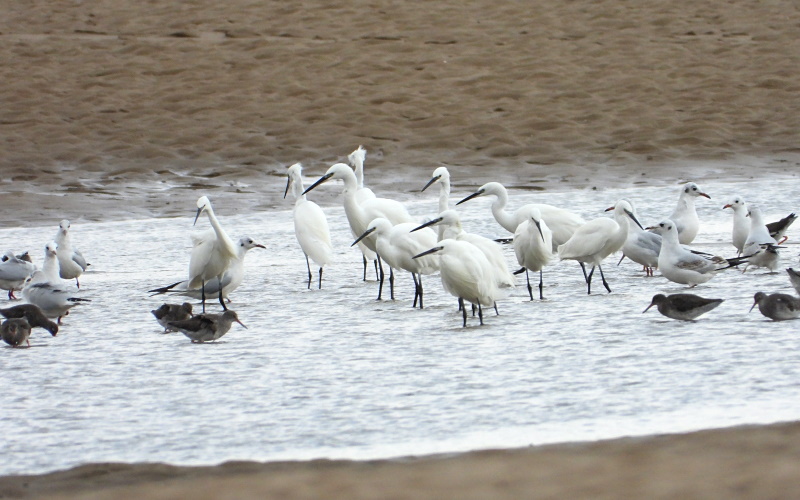
Having lived in our current house for 24 years Viv and I were having a
bit of a pre-Christmas clearout last month. Underneath a load of old
Dee
Estuary Voluntary Wardens leaflets and wader count forms I came across
a copy of the Dee Estuary WeBS Annual Report for 1999/2000. Quickly
looking through it I was intrigued when I realised it was the first
ever such report written (by Neil Friswell and edited by Colin Wells).
It was fascinating reading it because there have been some dramatic
changes to the estuary's birds over those 24 years, and reading the
report really brought that home. So I thought, using extracts from the
1999/2000 Report and comparing them with what is written in the the
current 2023/2024 Report, it would be of interest to choose 12 species
and show how their fortunes have changed.
Note that words in italics are direct quotes from
the reports, otherwise they are my own comments.
Little Egret
1999/2000: Now regularly recorded in all months of the year.... Maximum count 5 in September.
2023/2024: Peak count was 399 in September and
there were 88 nests in Marsh Covert. ...
a count of 620 in August 2024 suggests another surge in numbers...!
Bewick's Swan
1999/2000: Peak count was 56 in January. But the
highest ever WeBS count on the Dee Estuary was made the following
winter when there were 118 present.
2023/2024: None
were recorded again in this year's WeBS.
Whooper Swan
1999/2000: As
usual a few birds wintered on the Estuary with the maximum count of 8
occuring in January.
2023/2024: ... a peak of only 31 in January. Although current numbers are much higher than 24 years ago they actually peaked in Feb 2011 with 86. The Report asks the question is there an issue with the Dee Estuary as all swan species are in sharp decline?
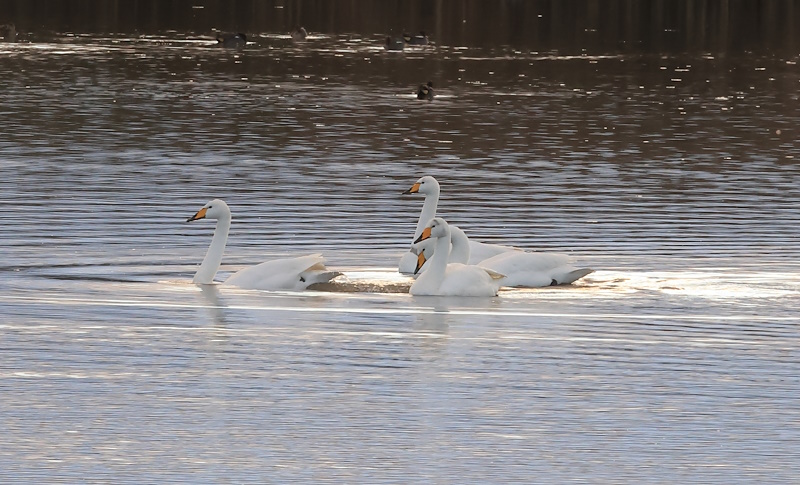
Pink-footed Goose
1999/2000: The maximum WeBS count was 66 on 23 January but higher counts were recorded, with up to 80 during late Jan to mid-February.
2023/2024: A
record count this winter and the five year average continues steadily
upwards.
That record count was 23,816 on Feb 11th 2024. Of all the species in
this article the increase in 'Pinkfeet' numbers has to be the most
spectacular. See the 'Pink-footed Geese' article in the October 2023
Dee Estuary Newsletter:
http://www.deeestuary.co.uk/news1023.htm.
Light-bellied Brent Goose
1999/2000: This winter the highest count was 8 birds which is typical of recent years.
2023/2024: WeBS
counts this year were 482, 561, 475, 638, 624, 399, 358 in October,
November, December, January, February, March and April respectively.
These are record counts....
Wigeon
1999/2000: Peak count was 2751 in December, not untypical for the previous 10 years.
2023/2024: Another
good peak count this year - the third highest over the last 38 years.
The count was 8293 in November.
Shoveler
1999/2000: The highest WeBS count was 77 on 12 September.
2023/2024: Very high counts again this winter, particularly September to November with an astonsihing 426 in the latter month.
Goldeneye
1999/2000: ...maximum count 16 in January - slightly down on recent winters (eg 31 in January 1999).
2023/2024: Three
records - one in December, one in January and two in February.
Goosander
1999/2000: No Goosanders reported.
2023/2024: Peak
count was 30 in November. Note there was a maximum of 36 on West
Kirby Marine Lake in December (on a non-WeBS count day).
Oystercatcher
1999/2000: There has been a steady decline in Oystercatcher numbers since 1993/94. That winter marked a low point in Oystercatcher numbers with a maximum of just 14,889 in September - down from a typical count of 30,000 to 40,000 prior to 1994. This decline was almost certainly due to over-fishing of the cockle beds, and the large amount of disturbance caused by the cocklers.
2023/2024: Some good counts this winter. The maximum count was 27,448 in September. The highest count in recent years was 30,362 in January 2022. The recovery in numbers is due to the Dee Estuary Cockle Order brought in in 2008 to strictly control the cockling industry. Can we have a similar Cockle Order for north Wirral please??
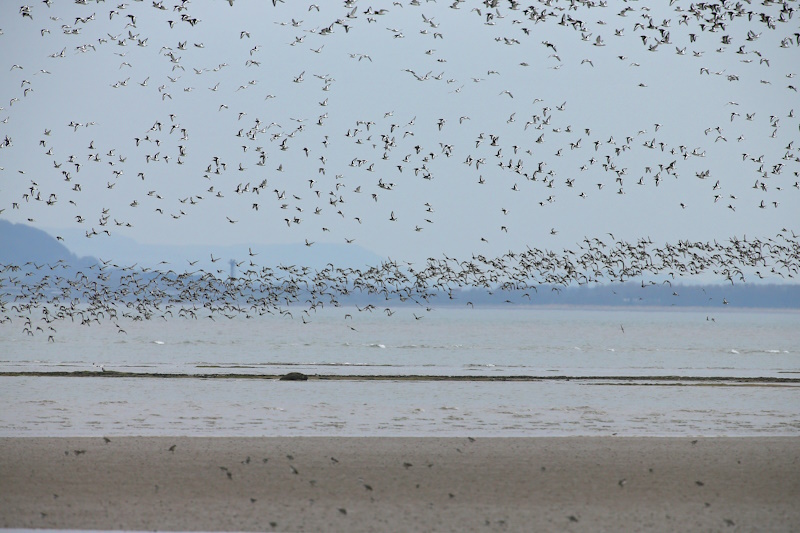
Purple Sandpiper
1990/2000: Peak count was 45 in February.
2023/2024: Peak count was 20 in December.
Black-tailed Godwit
1990/2000: There has been a large increase in numbers since the late 1980's.... Peak count was 2543 in November.
2023/2024: A
record count in August 2023..... Peak count was 10422.
The increase in Black-tailed Godwit numbers has been
well documented in this website - for example, see the 'Black-tailed
Godwits 2024'
article - http://www.deeestuary.co.uk/news1124.htm
References
1. Neil Friswell and Colin Wells, Dee Estuary WeBS Annual Report, 1999/2000.
2. Neil Friswell and Colin Wells, Dee Estuary and North Wirral Foreshore WeBS Annual Report, 2023/2024.
Also see the Wetland Bird Survey Annual Report
section on the BTO website:
https://www.bto.org/our-science/projects/wetland-bird-survey/publications/webs-annual-report
Richard Smith
Colour Ring Report
Great White Egret
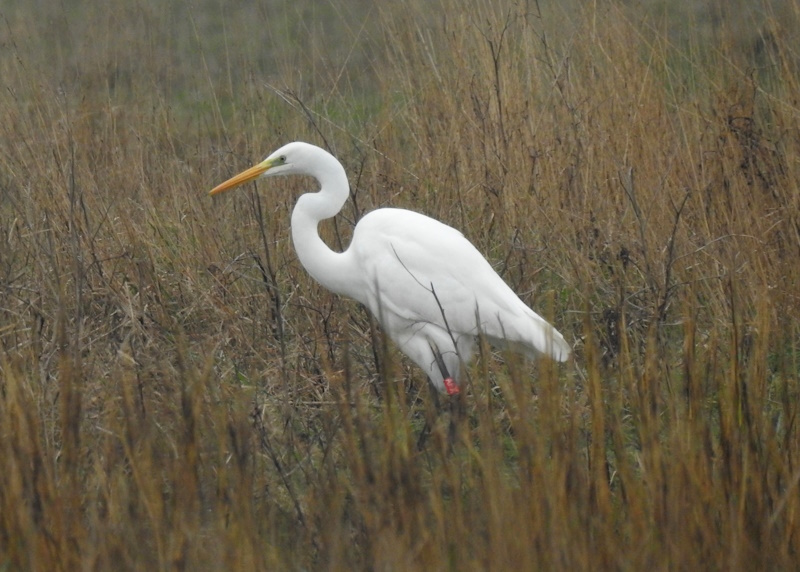
Red (AFX)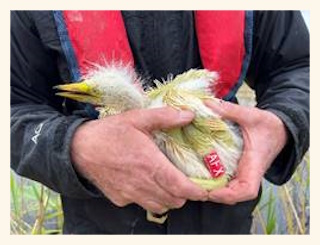
Ringed at Shapwith Heath, Somerset. It was the largest of a brood of
two when ringed (see photo right).
Recorded on Neston Marsh on 12/12/2024.
This was the first sighting of this bird since it left the nest.
Red (AFX) is the third colour-ringed Great White Egret which we've recorded on the Dee Estuary. Both the other two were also ringed on the Somerset Levels, one at Shapwith Heath and the other at Westhay, Avalon Marshes.
Oystercatcher
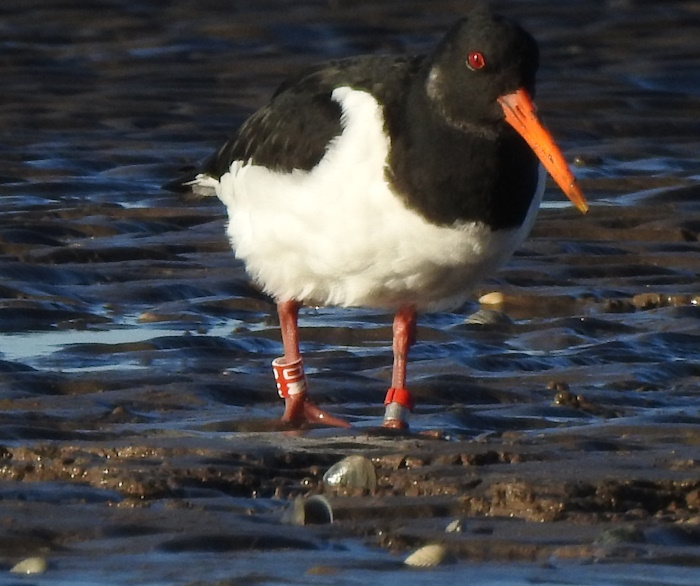
Red - Red(ON)
Ringed on the River Spey at Newtonmore, Highland (near Aviemore) on
17/03/2018.
Recorded on Thurstaston shore on 28/01/2020 and 29/11/2020, and on
Caldy Shore on 08/01/2024 and 09/12/2024.
Nigel Buxton, the ringer, said "itís good to know that ON has survived another year and is back on its wintering grounds. Iím always very glad to receive these sightings of our ringed birds; it makes the large efforts by a number of people to catch and mark these birds so worthwhile."
Knots
With several thousand Knots feeding and roosting
both at Thurstaston and Meols we had a good month for spotting ringed
birds and we had over 300 colour-ringed records in December. Here are a
couple of
examples.
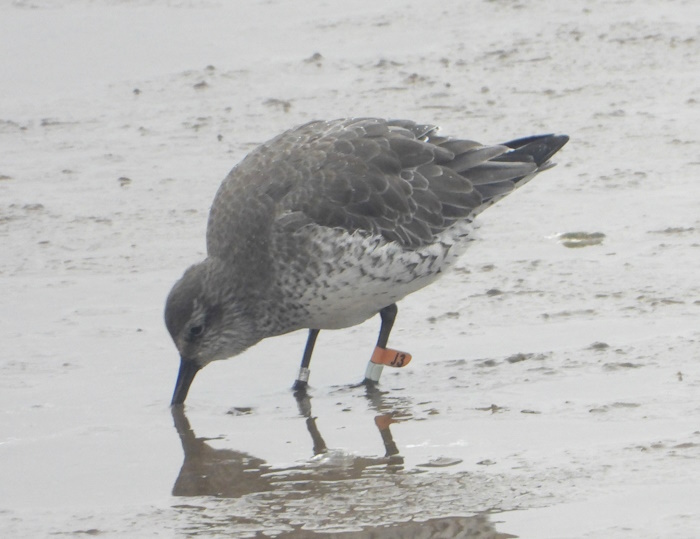
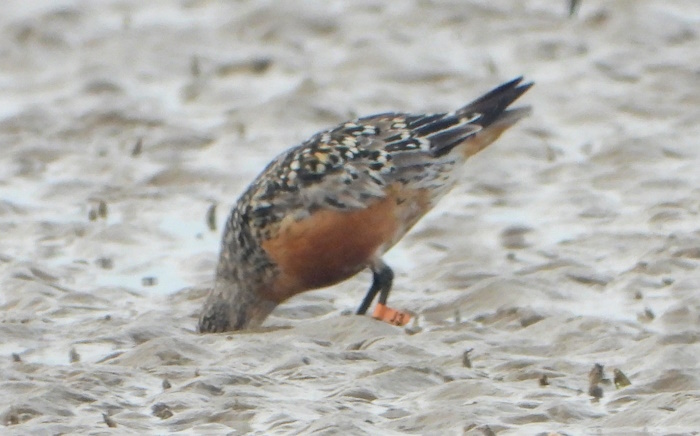
Oflag(J3)/P
This was ringed at Altcar in September 2017.
Since then it has been a regular having been recorded a total of 44
times. It's been seen 14 times at Meols, seven times at Thurstaston and
three at West Kirby. It was good to see it at Leasowe in August this
year in full summer plumage having just returned from breeding. The
last record was at Meols right at the end of the year, on December 30th.
Elsewhere, it's been recorded 14 times between Seaforth and Marshside, and in south-west Iceland in May 2018 and 2024.
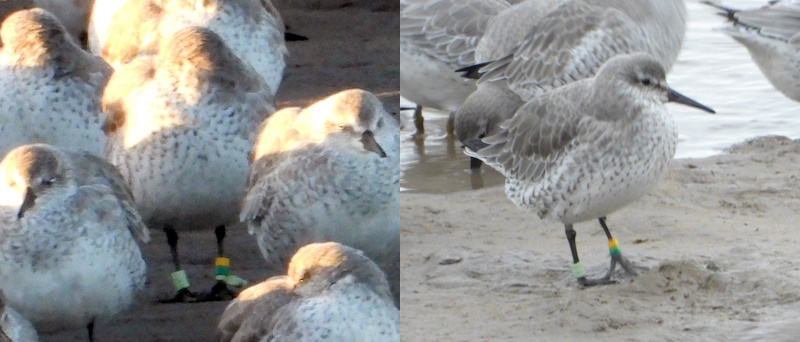
Note that in 2021 the Lime flag looked damaged and by 2024 it had disappeared.
L7YGLL
Ringed at Simonszand (Dutch Waddensea) on 24/08/2009. This bird is over
15 years old, a decent age for a Knot but, looking at the BTO website,
some can live much longer and the longevity record is 27 years!
Over the 15 years since it was ringed it has only
been seen five times. In May 2011 it was in north-east Iceland and it
was back in the Waddensea in July 2014. Our first record of it was in
December 2017 at Thurstaston, and it was there again in November 2021.
It was good to see it at Meols on December 17th this year.
'Photographic Guide
to
Colour-marked Red Knot' - download the PDF file by clicking here.
Colour Rings were recorded by Richard
Smith, Stephen
Hinde, Tony Ormond, Alan Hitchmough, Matt Thomas and Paul Ralston
Richard Smith
December Bird News
There haven't been huge numbers of Knots on the estuary so far this winter, but several thousand have been both feeding and roosting on Meols Shore giving fantastic views
Elsewhere, Gronant had some interesting birds starting with a Glaucous Gull on the shore - although some thought it was probably a hybrid Glaucous x Herring Gull. At least one Bearded Tit showed well several times in the reed beds there whilst offshore a Long-tailed Duck was spotted. By Flint Castle the usual Twite flock has been present, max count was 22 on Christmas Day. A Water Pipit was also seen on the marsh there several times.
The Little Stint at Hoylake/Meols was recorded several times, whilst 23 Purple Sandpipers roosting on Hilbre on the 29th was an excellent count.
On the marshes between Burton and Parkgate up to
three Hen Harriers (including two grey males) were recorded along with
several Marsh Harriers, but these was just two sightings of single
Short-eared Owls and one Bittern.
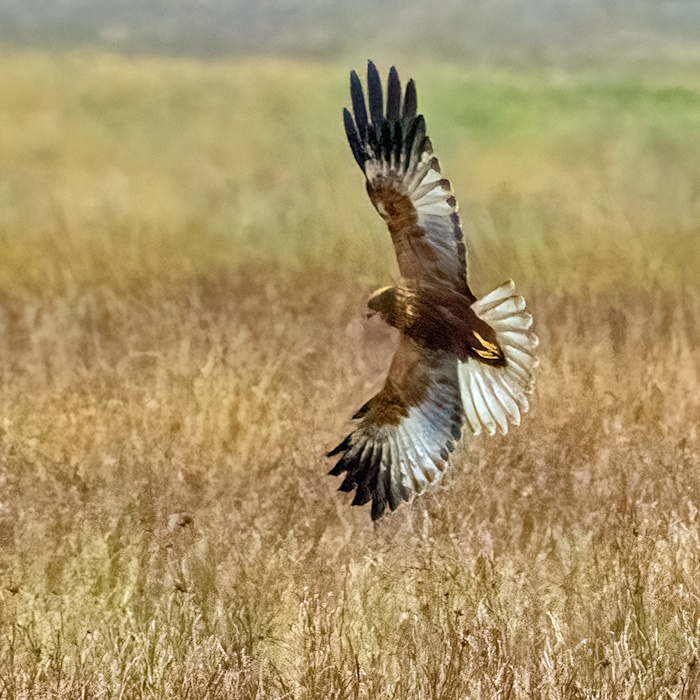
What to expect in January
Last January we were seeing a few hundred Waxwings on Halkyn mountain,
just to the west of the estuary, but sadly I don't think we'll be
seeing any this winter - although a late influx is not unheard of.
Out to sea we can expect the usual large Common
Scoter flock, probably several thousand strong, and we would expect to
see a few Velvet Scoters with them. Some winters we can also see
several hundred Great Crested Grebes out there, and may be a few
Long-tailed Ducks.
Both Goosanders and Red-breasted Mergansers are likely to be on West Kirby Marine Lake, hopefully also a few Goldeneye which are getting increasingly rare.
The large number of waders present in the estuary
this month should produce some spectacular high tide roosts,
Particularly at Point of Ayr, West Kirby and Hoylake. The highest tide
is on the last day of the month (see below) but, somewhat unusually,
there are five other dates where the tide will be high enough to bring
the waders close enough to get great views. Also look out for good
numbers of waders
at low tide, at Meols many waders feed close to the prom, whereas
Thurstaston has the largest numbers, particularly of Knot, Dunlin and
Oystercatchers.
January Highest
Tides:
2nd 12.35hrs (GMT) 9.3m
3rd 13.17hrs (GMT) 9.3m
15th 12.02hrs (GMT) 9.3m
16th 12.40hrs (GMT) 9.3m
30th 11.42hrs (GMT) 9.4m
31st 12.21hrs (GMT) 9.7m